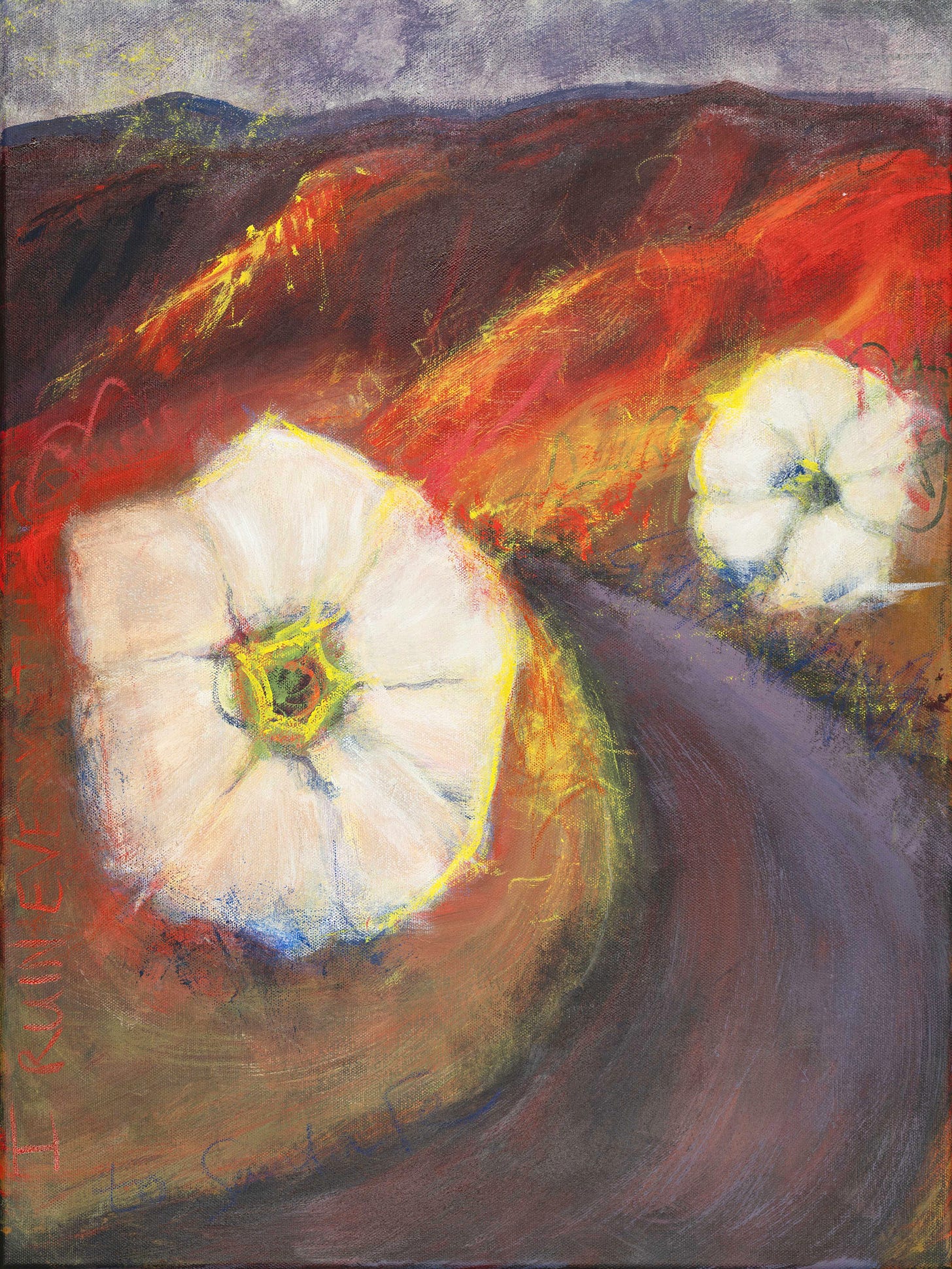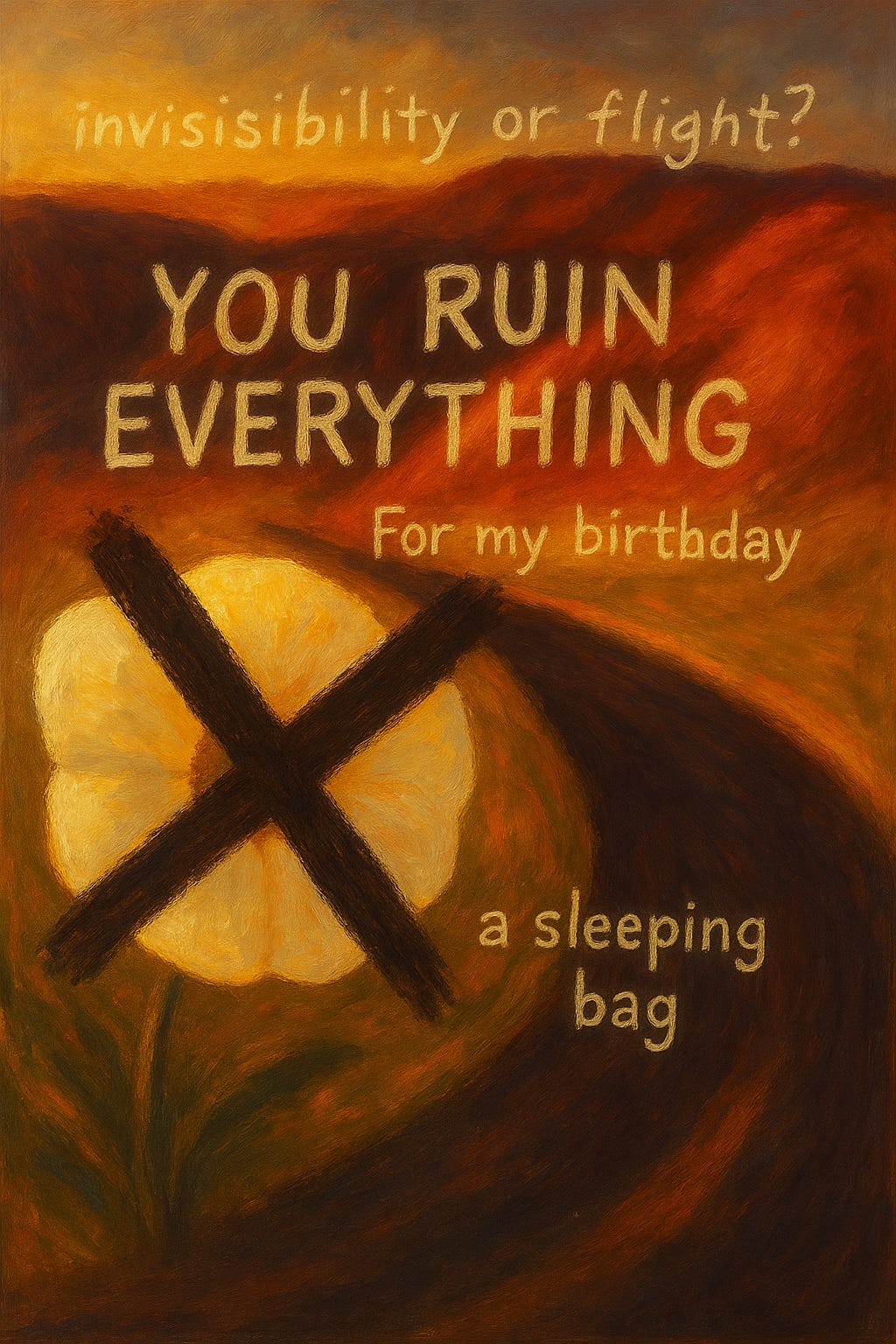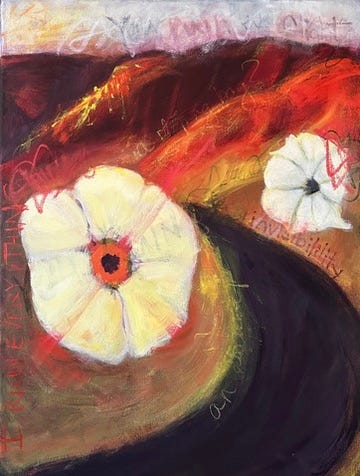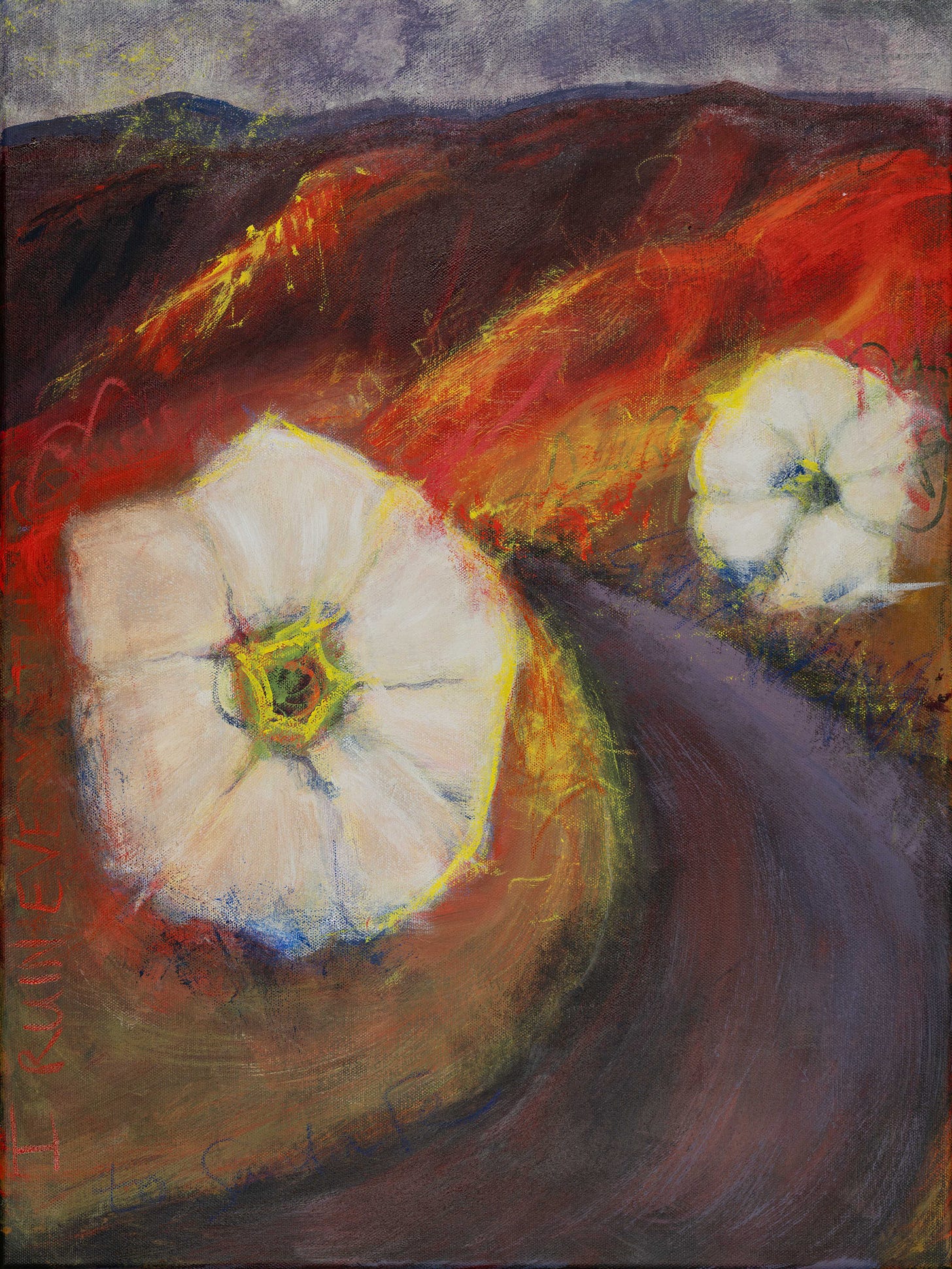Using AI as An Artist's Assistant
ChatGPT is a terrible artist, but great at offering critiques and suggestions that make your work better. How to use AI so it enhances your creativity rather than destroying it.
This week, I let ChatGPT help me ruin a painting.
Not in the “AI replaces human creativity” way you’ve heard about, I ruined it in a way that made the work more meaningful, more uncomfortable, and (I hope) more alive. This is the story of I Ruined: A Road Trip to Santa Fe, how it connects to my memoir-in-progress Things Men Gave Me, and what AI can (and can’t) do for artists.
I’ve been spending the past year sailing away from my career in tech to focus on something different and a little weird: writing a serialized memoir that brings together abstraction and story.
Along the way, I’ve been experimenting with using AI not as a replacement for creativity, but as an assistant who helps me improve upon what’s uniquely mine: what comes from my soul.
People in gaming use the term oneshotted to mean being taken out by a single hit. In Snow Crash, tweets Sarah Guo, a few words could reprogram someone’s mind, and she likens it to how AI changes your style. That’s fiction, but spend enough time working with AI and you might notice your own style playing its staccato, repetitive rhythms.
Is that oneshotting? I’m not so sure. That’s a process that happens over time, not with a single blast.
There’s another kind too: when AI oneshots the work itself, spitting out a whole essay or artwork from a single description. No sketches, no messy drafts, no wandering off-course, no flights of intuition, and no accidentally harmonious cacophonies of color. No texture and grit, built up over time. Just boom, finished.
However you think of oneshotting, ChatGPT isn’t going to oneshot your painting if you’re an abstract acrylic artist like me.
It’s a terrible artist, but a top-notch artist’s assistant.
I’m taking a sabbatical from technology work and focusing on art and writing. My most recent effort, Things Men Gave Me, is both a memoir and an art series, pairing essays about my romantic life after divorce with paintings inspired by each story. In these stories I—or rather the character I’ve been turned into—often acts ridiculously, I know. The stories I’m telling still hurt sometimes to think about and write. Sharing them publicly is uncomfortable but somehow invigorating too.
As David Bayles writes in Art & Fear:
Making art can feel dangerous and revealing. Making art is dangerous and revealing. Making art precipitates self-doubt, stirring deep waters that lay between what you know you should be, and what you fear you might be.
AI helps me progress, even when I feel scared of what I might say or paint. I don’t use it to write my essays or conceptualize the paintings. I use it to give me an outside, if sycophantic, view of my work once it’s far along.1 It suggests small refinements I wouldn’t have otherwise thought of. Sometimes it suggests things I thought about, but didn’t prioritize until I heard someone else (someone algorithmic) say it.
I’ve found that ChatGPT, while terrible at generating art, is very good at looking at my art and suggesting ways to improve it. Similarly, it’s useful as a writing editor to help me strengthen arguments I’ve already developed and tighten verbiage I’ve already composed.
Here, I’m going to share my experience using AI to help me with the painting I’ve included above, I Ruined: A Road Trip to Santa Fe, which pairs with my essay Christopher Gave Me: An Abalone Pendant Instead of a Sleeping Bag.
This painting is, to me, conceptual art. I consider myself, most authentically, a conceptual artist.
What is conceptual art? Art where the idea and conception behind the artwork is as or more important than its aesthetic and decorative value. It is art of the mind, intended to make you think.
In the essay which inspired this painting, I was told by my road trip partner, “You ruin everything.”
This gave rise to my idea that I could first paint an artwork suggesting a road trip to Santa Fe. Then I could ruin it.
See? I do ruin everything! I ruined my painting that seemed like it would just be a pleasant representation of a drive to New Mexico.
The (final) painting is intended to be aesthetically pleasing (if you like my sort of messy layered abstracted style) but more important it’s intended to communicate meaning: that whatever I do is covered with a mess of drips no one needed and loud color where it wasn’t asked for and things you didn’t want to hear.
First I painted a sunny, Georgia O’Keeffe-esque landscape with red hills, a large jimsonweed flower, and a winding road. I was inspired by her lovely 1937 pastel, Red Hills and White Flower.
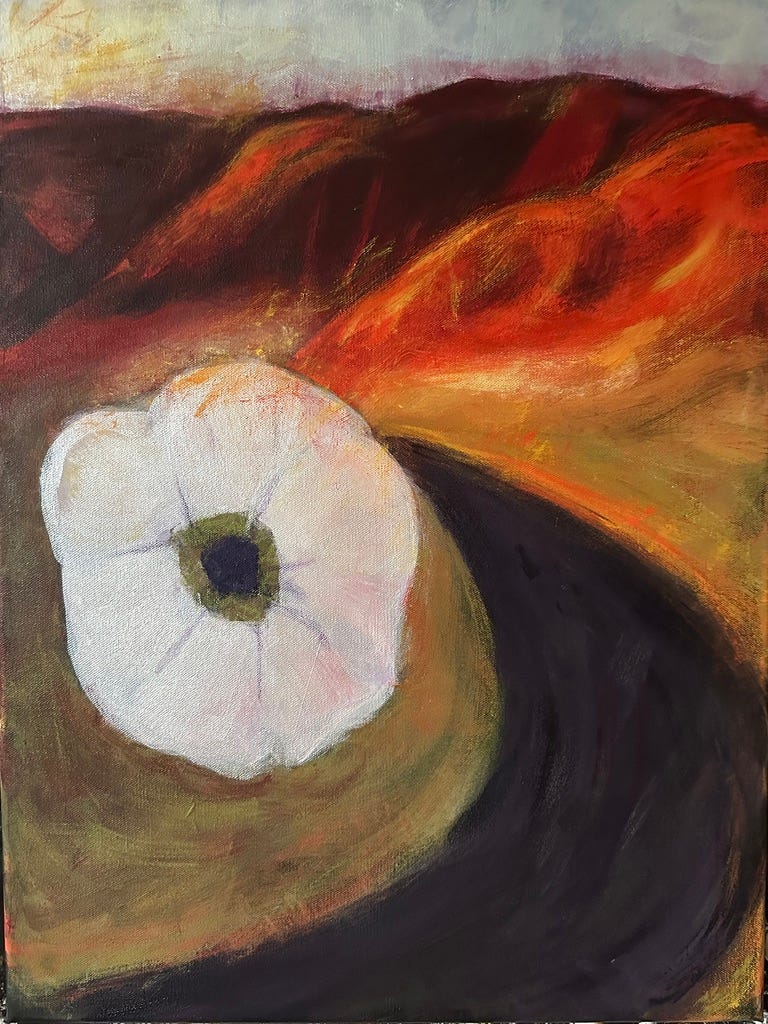
I don’t typically paint representationally but I thought it was an alright painting. It was certainly not in my usual style but a good effort nonetheless, and a perfect candidate for ruination.
It felt terrible to ruin it, but as a conceptual artist, I felt compelled to push forward. That tension between pain and necessity is part of the work.
As Polish sculptor and fiber artist Magdalena Abakanowicz put it:
Art will remain the most astonishing activity of mankind born out of struggle between wisdom and madness, between dream and reality in our mind.
The paintings I’ve completed for Things Men Gave Me so far do express all these things: wisdom and madness, dream and reality.
Now, a brief digression to show you just how terrible an artist ChatGPT is.
Here’s its mocked up version of how I might ruin my painting:
I began ruining the painting by scribbling on it, writing on it, and adding new elements such as a second flower. Chat had, at one point, mocked up a version of this composition with two additional flowers. I liked the idea of adding another one. It’s almost like the two flowers could be me and my road trip companion.
Now the painting was at the stage where ChatGPT could really help. It isn’t good at conceiving of an artwork. It’s not very good at mocking up visual ideas. But it’s great at suggesting small changes once an artwork has progressed to the point where it really expresses an artist’s point of view.
Chat told me what was working, and, more important, suggested improvements:
Warm highlights on the second flower to tie it into the hills
Lighting the left edge of the road to suggest movement
A few crisp details in petals and hills to punctuate the piece
I did go through a few more iterations of the painting, with ChatGPT making various suggestions, to reach the final painting at the top of this essay. I’m pleased with it and I don’t think it would be as good without the AI suggestions.2
Here’s the final ruined version (same as shown at the top of this article):
Anu Atluru, a writer and startup founder, calls this “upstream” and “downstream” help. AI can brainstorm before you start or critique after you finish, but it can’t do the “messy middle” for you. I’d go further: the most important part of any creative project happens even earlier, when you decide what you want to make and why. That’s the part you can’t outsource: conceptualizing.
For example, you never start vibe coding without conceptualizing first.
Just as with art, with writing you need to conceptualize what’s unique and soulful for you before you get AI involved.
I blog every day for my 1000-day project, documenting my lengthy and leisurely journey of midlife reinvention. Some days I don’t know what to write about. So do I ask Chat, “What should I write about today?”
Sort of. Not really. I start out with something more targeted than that.
For example, here’s a recent prompt I used:
Need to brainstorm what to blog about today on my 1000-day blogging project. Today is "Thursday Thinker," where I share an interesting idea or theory. I'm in the middle of questioning who I am as I move from being centered in my family (my parents, my kids, my sisters) at age 57 to centered in a new relationship (with Ray).
Maybe there's some Jungian thinker I can write about, I'm thinking about "enantiodromia"?
Chat gave me a bunch of suggestions including checking out the work of Jungian storyteller and author Clarissa Pinkola Estés. That led to my purchasing a Kindle version of Women Who Run with the Wolves, and writing a blog post about how Skeleton Woman is chasing me. Other than asking Chat to write a paragraph summarizing the Skeleton Woman story, I wrote that blog post all on my own, without any AI help.
The suggestion of Clarissa Pinkola Estés was right on though.
I wanted to process the information myself. I wanted to be changed in the process of conceiving of a topic and then writing about it and sharing what I learned. The point wasn’t to produce a final blog post, but to produce a change in me. And, I hope, a change in anyone who read that post.
Deciding on a blog post topic is an upstream activity, but crucially the artist must be in charge. I don’t think I would have come up with a good concept for a blog post just by asking Chat to give some ideas for blog posts. I’ve tried something like that and (fortunately for us creators!) it comes up with really boring ideas when it works all on its own.
AI can’t do the main thing for you, whether that’s thinking up a conceptual artwork, deciding the heart of an essay, developing a composition and color scheme for a painting, or figuring out what you want to say about your own life. That part is yours to wrestle with and make your own.
Things Men Gave Me is doing that, in public, one essay-painting at a time. The first three are available to read now. New essays with paintings will be published every two to three weeks.
If you want to follow along and receive limited-access content I only send to my email list, you can sign up here.
Are you using AI to help you with writing, art, or something else? Share your experiences here.
It’s helpful, actually, that ChatGPT is very positive and validating about my work. It’s not easy to share such personal creations and I’m not sure I would do so if they were harshly critiqued during their development.
It can even tell me how to do something. It can suggest paint colors, glazing techniques, brush size and texture, and how to make marks or strokes.


